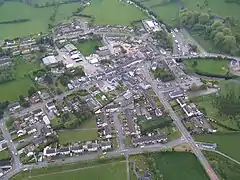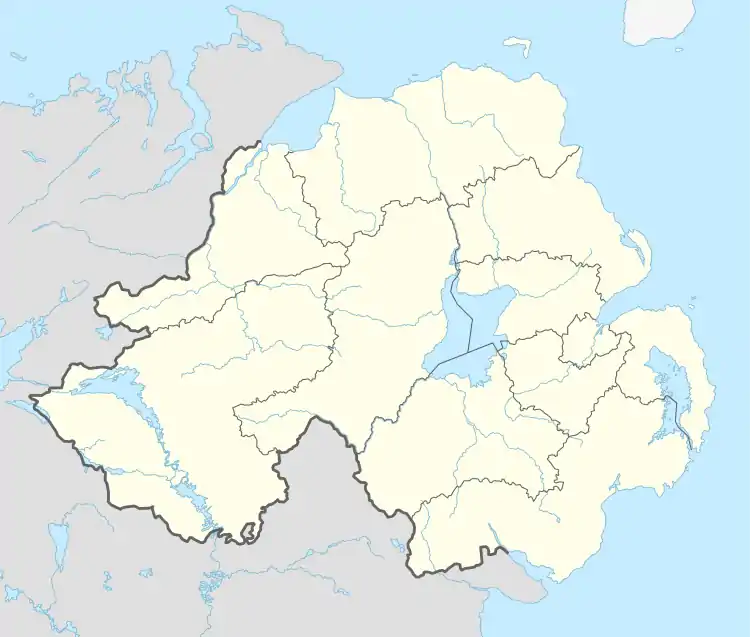Kesh, County Fermanagh
Kesh (from Irish Ceis 'wicker bridge') is a village in County Fermanagh, Northern Ireland. It is on the Kesh River about 1 mile (1.6 km) from Lower Lough Erne. The 2011 Census recorded a population of 1,039 people.[1] It is within Fermanagh and Omagh district.
Kesh
| |
|---|---|
 | |
 Kesh Location within Northern Ireland | |
| Population | 1,039 (2011 Census) |
| District | |
| County | |
| Country | Northern Ireland |
| Sovereign state | United Kingdom |
| Post town | Enniskillen |
| Postcode district | 93 |
| Dialling code | 02868 |
| UK Parliament | |
| NI Assembly | |
Because of its location close to Lough Erne the village has been a popular tourist resort. It has two caravan parks, a small attractive marina and other related industries both within its boundaries and the surrounding area. It is about 5 miles (8 km) from the border with the Republic of Ireland and 22 miles (35 km) from the Atlantic coast resort of Rossnowlagh in County Donegal, thus adding to its popularity with holiday makers, day-trippers and weekenders.
History
Name
The toponym Kesh comes from ceis, the Irish word for 'wicker bridge', which refers to the crossing in the middle of the village. The village is not built around a parish church or chapel. Two Church of Ireland parishes of Magherculmoney and Tubrid meet at the river and their respective parish churches are each about 2 miles (3 km) either side of the village.
Kesh began as a ford or crossing place on the Glendarragh River. In the past, Lough Erne came very much closer to the village than it does today. Before the first great Erne Drainage in the 1880s, the lake was about eight feet higher and, especially in time of flood, may almost have reached Kesh. The ráth on Rosscah Hill above the late Joe Robert's house (a former rectory of Drumkeeran Parish) indicates original settlement here probably as far back as the Iron Age, c. 2000 years ago. There are two ráths on this hill, but the nearer to the house is believed to be a decorative feature made at the time of the construction of the house in the late 1700s. The large standing stone in Rosculban may be a relic of the Iron Age as well.
After a time, the ford was augmented with a wicker bridge, for which the Gaelic word is ceis, and hence the village got its name. The name had been spelt in varying ways but generally as Kish or Cash until relatively modern times. An ancient saying in the locality, which may refer to basket making and osier working in the area, states that anyone gifted with a big behind "had an arse on them like a Kesh creel."
Crevenish Castle
The remains of Crevenish Castle are south-east of the village on the Crevenish Road, or 'the back road' as the locals call it. During its time it was home to the Blennerhasset and Maguire families in the seventeenth-century and eighteenth-century.
The Troubles
On 2 December 1984, 28-year old Alistair Slater, a member of 22 SAS of the British Army, and 27-year-old Antoine Mac Giolla Bhrighde, a Provisional Irish Republican Army (IRA) volunteer, were both shot dead during an IRA ambush and a gun battle between an undercover 22 SAS British Army units and an IRA active service unit near Kesh. 26-year old Kieran Fleming, an IRA volunteer, drowned in the Bannagh River, near Kesh, as he tried to escape from the gun battle. The IRA men had been attempting to bomb a Royal Ulster Constabulary police car in Kesh. Slater was posthumously awarded the Military Medal for his bravery in the action.[2][3]
Slater's Directory 1870
This information from Slater's Directory of 1870 tells of the economic activity about Kesh at that time.
| BAKER | Bernard Kelly |
| BLACKSMITH | Alexander Coulter and Henry Irwin |
| BOOT AND SHOE MAKERS | Bernard Flynn, Terence Harran, James Irwin, Samuel Mc Caffrey and William Wherry |
| CARPENTERS AND CART MAKERS | William Mc Clintock |
| CHINA, GLASS AND EARTHENWARE DEALERS | William Gilmore |
| EMIGRATION AGENTS | James Aiken |
| GROCERS | James Aiken, Richard Elliott, Adam Eves, William Gilmore and Bernard Kelly |
| GUANO DEALERS AND SEEDSMEN | James Aiken |
| HARDWAREMEN | James Aiken and William Gilmore |
| LINEN AND WOOLLEN DRAPERS AND HABERDASHERS | James Aiken |
| MILLINERS AND DRESSMAKERS | Catherine Doonan |
| NAIL MAKERS | William Graham and Joseph Mc Barron |
| PHYSICIANS AND SURGEONS | Baptist G Graham, Drumrush, Kesh |
| POSTING HOUSES | Adam Eves |
| SPIRIT AND PORTER DEALERS | William Aiken, William Campbell and Thomas Muldoon |
| TAILORS | Patrick Doonan and Edward Johnston |
| TIMBER IRON AND COAL MERCHANTS | James Aiken |
| KESH RAILWAY STATION | James Connell, Station Master |
| CONSTABULARY STATION | Thomas Lewers Sub-Inspector, Thomas Kernan, Head Constable |
Local attractions
- The Lough Erne Hotel, originally a Royal Irish Constabulary barracks, later a tapestry house, and now the only hotel in Kesh by the Glendurragh River at the top of the main street. Still has the old gaol doors intact from the 1800s.
- Belleek Pottery, world famous producer of Parian china.
- The Boa Island carved stones, graveyard and enclosure are Scheduled Historic Monuments sited in the townland of Dreenan 5 miles from Kesh
- Castle Archdale Estate and marina, a large amenity that includes gardens, walks, water sports and other facilities; the complex also has a large caravan and camping park
- Drumrush Lodge, a restaurant and caravan park that also has a private marina that offers a full range of water sports
- Lough Erne is nearby and linked with Kesh by a navigable river terminating at the marina in the middle of the village beside the Lough erne Hotel
- The Manor House Hotel, 6 miles (10 km) away in Killadeas, provides golf and water sports facilities as well as a private leisure club and swimming pool
- Muckross, an inland lakeside 'beach' which used to be popular with families is now taken over almost exclusively by jet-skiers. It is south of Kesh, about 1 mile (1.6 km) from the village on the shore of Lough Erne
- North Fermanagh Club, a football (during winter) and cricket (during summer) venue on the Crevenish Road
Kesh Primary School
The date the school was established is unknown but the Clogher Records record a school in Kesh, Rosscolban in 1820 beside the schoolmaster's house. The original building was built in 1865 (as marked on the memorial stone on the front of the school). In 1957, the Right Hon Edward Archdale paid for the renovation of the school of 1 classroom making it into 3 classrooms and a PE hall. Many children were demanding enrolment as a result of the closure of other rural schools in 2001 WELB decided to build a new school. Building started in 2006 and the same year the school was ready to intake an average of 200 children.
Notable people
- Comedian Frank Carson spent time as plasterer in Kesh and is responsible for the work in some of the local authority housing on the Ederney Road. He is warmly remembered.
- Although born in Oxford, former Arsenal and England defender Martin Keown spent a lot of his childhood in Kesh as his father is from near the village.
- Former England cricket captain, Michael Vaughan has often been spotted in Kesh, his wife Nichola is from a village nearby.
- Frank Ormsby, poet and former editor of The Honest Ulsterman, lives in the neighbouring village of Irvinestown.
- Kyle Lafferty, former Rangers player, born in Kesh
Transport
Kesh railway station on the Enniskillen and Bundoran Railway was opened on 13 June 1866 and closed on 1 October 1957.[4]
The greatest impetus ever provided to Kesh was the arrival of the railway in 1866. It provided employment and a focus for traffic to and from the station. Hardware shops and shops providing for the needs of farmers could now carry a greater variety of goods and stock could be replenished more quickly than by horse and cart. Cattle and other livestock could also be transported to distant markets after being bought in local fairs such as Ederney and Lack itself. Butter and eggs could be produced in greater quantities and markets in Belfast and Dublin easily reached by train. Another boon to Kesh was the establishment of the Creamery there although this was done against much local opposition.
Ulsterbus routes 194 (Enniskillen to Pettigo) and 83A (Omagh to Kesh) stop in Kesh
Demography
On Census Day (27 March 2011) the usually resident population of Kesh Settlement was 1,039, accounting for 0.06% of the NI total.[1] Of these:
- 18.67% were aged under 16 and 16.84% were aged 65 and over
- 49.57% of the population were male and 50.43% were female
- 19.35% belong to or were brought up in the Catholic religion and 76.9% belong to or were brought up in a 'Protestant and Other Christian (including Christian related)' religion; and
- 72.67% indicated that they had a British national identity, 10.68% had an Irish national identity and 22.81% had a Northern Irish national identity.
References
- "Census 2011 Population Statistics for Kesh Settlement". Northern Ireland Statistics and Research Agency (NISRA). Retrieved 2 May 2021.
 This article contains quotations from this source, which is available under the Open Government Licence v3.0. © Crown copyright.
This article contains quotations from this source, which is available under the Open Government Licence v3.0. © Crown copyright. - http://www.london-gazette.co.uk/issues/50391/pages/240 Slater profile
- "CAIN: Sutton Index of Deaths".
- "Railscot: Kesh, Fermanagh" (PDF). Railscot-Irish Railways. Retrieved 16 October 2007.